Next-generation technology for ocean resources plan (Zipangu in the Ocean program)
Japan depends almost entirely on imports for mineral resources. Historically, Japan had produced large amounts of precious metals, gold and silver. With a few exceptions metal producing mines are exhausted. Recently, however, new sources of mineral resources have been discovered on the seafloor surrounding the Japanese archipelago. Mineral resources now found on land in Japan originated on the sea floor before the archipelago's formation. Similar resources are still forming on the sea floor.
The exclusive economic zone (EEZ) surrounding Japan is twelve times larger than the area of Japan itself. Efficient exploration of the seas around Japan is, therefore, likely to discover new sources of valuable minerals.
For this purpose, technology that different from used in oil and gas exploration is required. Because profitable production of mineral resources from the ocean floor is not possible with existing technology, nowhere in the world do we see full-scale development of maritime mineral resources. New technology must be developed to overcome this problem and allow the private sector to explore efficiently larger regions of the ocean floor.
Japan's government has taken the lead, starting with tie-ups between government agencies to pull together research organizations that will work together todevelopthescience and technology required to explore the seas around Japan. Program members are joining forces to develop theories of resource formation and construct a system for efficiently exploring selected parts of the ocean floor, based on scientific knowledge. They are also promoting development of technology to assess the environmental impact of resource exploration and extraction. Plans call for strengthening Japan's capabilities in ocean resource exploration by transferring the results of this effort to the private sector. The development of next-generation technology for ocean resources development, the Zipangu in the Ocean program is now underway.
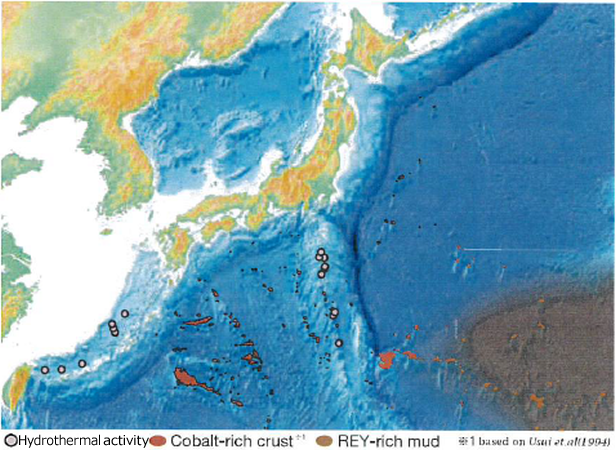
Distribution of marine mineral resources in waters around Japan
The Zipangu in the Ocean Project aims to develop technologies mainly to explore three specific types of marine mineral resources on the seabed in waters around Japan.
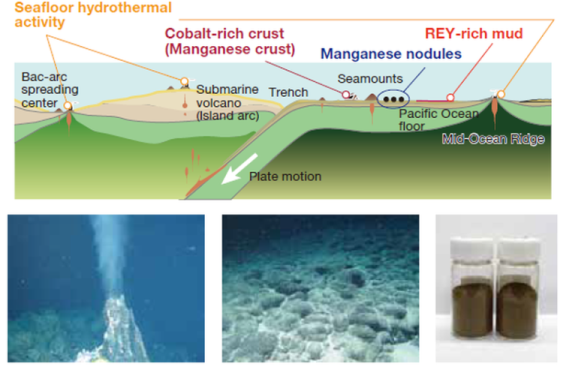
Marine mineral resources on the seabed
However, it is not easy to discover and collect these resources due to the following differences from onshore mineral resources exploration.
Exact locations are still unknown.
As the exact location, distribution, density, and form of marine mineral resources are still unclear, it is not yet known where potential exploration spots exist. The lack of such information means it is like searching for something with only a flashlight in complete darkness—requiring a great deal of time to discover it.
No efficient survey methods have been established.
Unlike onshore exploration, radio waves do not propagate underwater, which makes it impossible to take an aerial survey using satellites. For this reason, sound waves and electricity are used for underwater exploration activities, while various ocean-specific obstacles make it difficult to obtain accurate information. As of today, there are no well-established methods to survey the seafloor promptly and precisely.
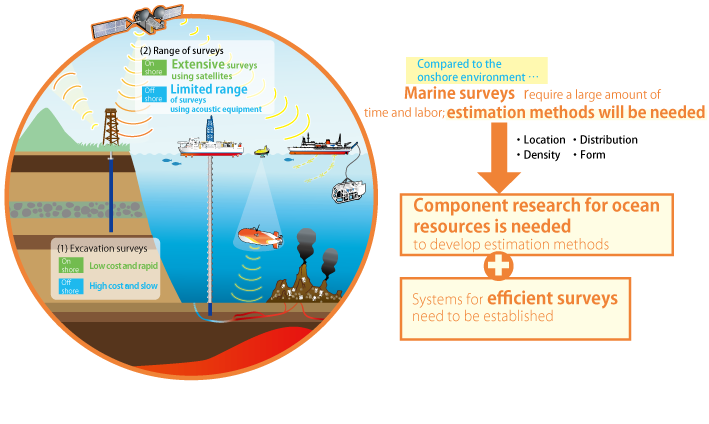
Differences between onshore and offshore survey methods

Differences between onshore and offshore survey methods
Marine ecosystems are still unclear.
For onshore mining development, it is necessary to reduce possible impacts on surrounding ecosystems. The same measures need to be taken for offshore development. Unlike onshore, however, offshore development still has insufficiently clear rules and environmental observation technologies.
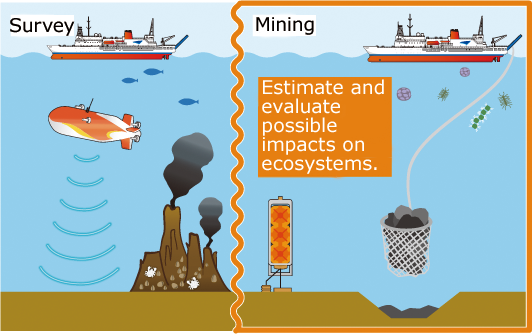
Marine ecosystem surveys in resources development

Marine ecosystem surveys in resources development
In the next-generation technology for ocean resources exploration, JAMSTEC will carry out the followings to address the problems above.
Survey the formation of marine mineral resources and develop technologies to estimate
their presence.
Studying the formation of these marine mineral resources is expected to scientifically identify where, to what extent, and in what conditions they exist.
Develop equipment and technologies to efficiently explore the seafloor and discover
marine mineral resources.
Efficient survey methods will be developed that utilize autonomous underwater vehicles (AUVs), remotely operated vehicles (ROVs), towing vehicles, and other underwater search equipment.
Draw up standards to reduce the impacts of marine mineral resources development
on the marine environment.
Standards and measurement methods will be specified to identify accurate impacts of development and maintain sustainable ecosystems in response to the progress of ocean resources exploration technology and future resources development.
![Subject Summary[Implemenation System and Strategical Goal]](images/btnOverview2.png)
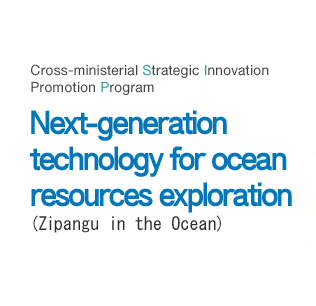
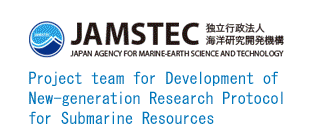

![Subject Summary[Implemenation System and Strategical Goal]](images/btnOverview2-1.png)